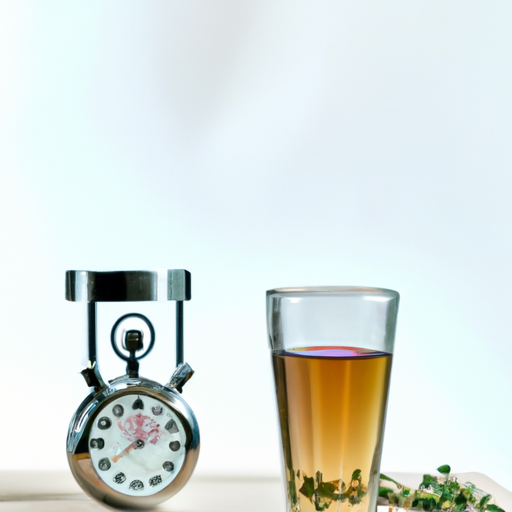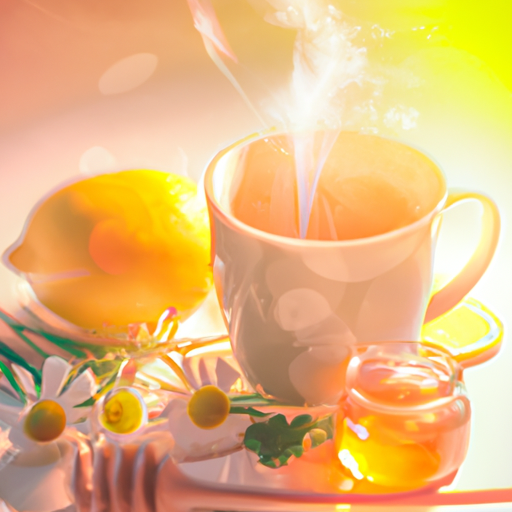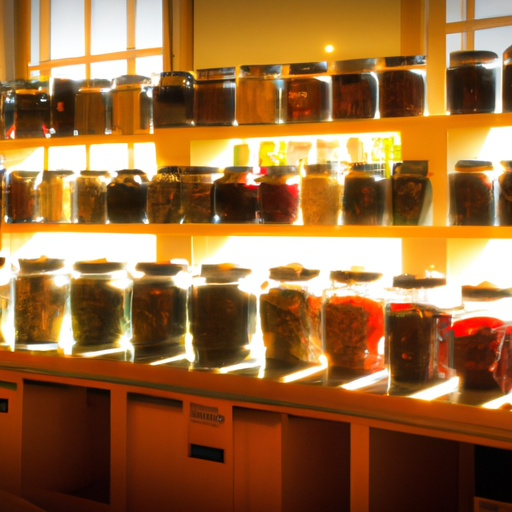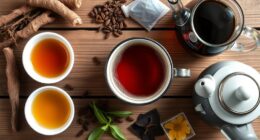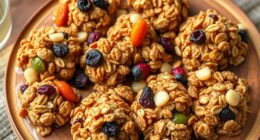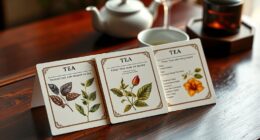Brewing loose leaf herbal tea is akin to soaking in a calming bubble bath of delightful botanicals, letting the scents and tastes wrap around you. Similar to how everyone has their ideal warmth for a cozy bath, the best brewing duration for herbal tea differs depending on the individual. If you want to truly savor the essence of your herbal tea, finding your perfect steeping time is key. Dive into the world of herbal tea brewing and discover your personal flavor paradise!
In this article, I will guide you through the art of steeping loose leaf herbal tea, ensuring that you achieve the ideal infusion every time.
With a plethora of herbal teas available, it can be overwhelming to know exactly how long to steep each variety. Fear not, for I will provide you with a comprehensive guide on the optimal steeping times for common herbal teas. Moreover, I will share tips for adjusting steeping times to suit your personal taste preferences.
Additionally, I will reveal some techniques for enhancing the flavor of your loose leaf herbal tea, as well as common mistakes to avoid while steeping. Lastly, I will also delve into various steeping methods and offer advice on storing and preserving your tea leaves.
Prepare yourself for a journey into the world of loose leaf herbal tea steeping, where you will unlock the secrets to a truly delightful and invigorating experience.
Key Takeaways
- Steeping time for herbal tea varies depending on the type of tea
- Different water temperatures should be used for different herbal teas
- Steeping releases beneficial compounds and antioxidants in herbal tea
- Adjusting steeping times allows for customization of the flavor and strength of herbal tea
Understanding the Basics of Steeping
Do you ever wonder how long you should let your loose leaf herbal tea steep to get the perfect flavor? Well, let me break it down for you.
The first step is adjusting the water temperature. Different herbal teas require different water temperatures to bring out their flavors. For delicate herbal teas like chamomile or peppermint, a lower water temperature of around 180°F is recommended. On the other hand, robust herbal teas like ginger or hibiscus can handle boiling water.
The second step is understanding the health benefits. Steeping loose leaf herbal tea releases the beneficial compounds and antioxidants that promote wellness. For example, chamomile tea can aid in relaxation and digestion, while ginger tea can soothe an upset stomach.
Now that you understand the basics of steeping, let’s dive into the specific steeping times for common herbal teas.
Steeping Times for Common Herbal Teas
When it comes to steeping herbal teas, it’s important to know the ideal steeping times for different varieties. For chamomile tea, I recommend steeping it for about 5 minutes to bring out its soothing and calming properties.
Peppermint tea, on the other hand, should be steeped for 3-5 minutes to extract its refreshing and minty flavors.
Lastly, lavender tea should be steeped for around 7-10 minutes to fully infuse its floral and relaxing aroma.
Chamomile Tea
Chamomile tea, like a gentle lullaby for the senses, should be steeped for about 5 minutes to release its soothing flavors and aromas.
This delightful herbal tea not only offers a delightful taste experience but also provides numerous benefits. Chamomile tea is known for its calming properties, making it the perfect beverage to enjoy before bedtime. It can help promote relaxation and relieve stress, making it a popular choice for those seeking a peaceful night’s sleep.
Additionally, chamomile tea is believed to have anti-inflammatory and antioxidant properties, which may help support overall wellness. To fully enjoy the benefits of chamomile tea, it is recommended to drink it in the evening, allowing its calming effects to prepare you for a restful sleep.
Now, let’s move on to the invigorating qualities of peppermint tea.
Peppermint Tea
Indulge yourself in the invigorating qualities of peppermint tea, and let its refreshing flavor awaken your senses. Peppermint tea isn’t just a delicious beverage, but it also offers numerous health benefits.
The menthol in peppermint helps soothe an upset stomach and relieve digestive issues. It’s also known to alleviate headaches and boost energy levels. When choosing the best peppermint tea brands, look for those that use high-quality, organic peppermint leaves to ensure maximum flavor and potency.
Some popular brands include Traditional Medicinals, Harney & Sons, and Stash. These brands are known for their commitment to sourcing the finest ingredients and providing a delightful tea-drinking experience.
Transitioning to the subsequent section about lavender tea, another herbal tea with its own unique benefits, we find a calming and soothing option for relaxation.
Lavender Tea
Savor the calming and soothing qualities of lavender tea as you let its delicate floral aroma transport you to a state of relaxation. Lavender tea isn’t just delicious but also offers a range of health benefits.
Here are a few lavender recipes that you can try to incorporate this fragrant herb into your daily routine:
-
Lavender Lemonade: Refreshing and invigorating, this drink combines the floral notes of lavender with the tangy zest of lemon.
-
Lavender Shortbread Cookies: Indulge in the subtle lavender flavor of these melt-in-your-mouth cookies.
-
Lavender Infused Honey: Drizzle this sweet and floral honey over your favorite desserts or use it to add a unique twist to your tea or toast.
In addition to its pleasant taste, lavender tea has been known to promote relaxation, reduce anxiety, and aid in sleep. Adjusting steeping times for personal preference allows you to customize the strength of the tea to suit your taste.
Transitioning into the next section, let’s explore the various factors that can affect the steeping time.
Adjusting Steeping Times for Personal Preference
Experimenting with steeping times allows me to tailor the strength and flavor of my loose leaf herbal tea to suit my own personal preferences. By adjusting the infusion time, I can control how strong or mild the tea tastes. If I want a stronger flavor, I can steep the tea for a longer period of time. On the other hand, if I prefer a more subtle taste, I can reduce the steeping time.
Additionally, experimenting with different flavors is another way to enhance the taste of my tea. For example, I can try adding a slice of lemon or a sprig of mint to create a refreshing twist. These adjustments make each cup of tea a unique and enjoyable experience.
Speaking of enhancing flavor, there are also other tips I can share to elevate the taste of loose leaf herbal tea.
Tips for Enhancing the Flavor of Loose Leaf Herbal Tea
To enhance the flavor of your loose leaf herbal tea, try infusing it with fresh fruits or fragrant spices. This not only adds a burst of flavor, but also enhances the aroma of your tea.
For example, you can try adding slices of citrus fruits like lemon or orange, or even a few sprigs of mint for a refreshing twist. Additionally, choosing the right water temperature is crucial for achieving the perfect flavor profile. Herbal teas generally require a lower temperature compared to black or green teas. It’s recommended to use water that’s around 200°F (93°C) for most herbal teas. This allows the flavors to fully develop without becoming bitter.
By following these tips, you can create a delightful and flavorful cup of loose leaf herbal tea. Now, let’s move on to avoiding common steeping mistakes.
Avoiding Common Steeping Mistakes
Avoid the rookie mistake of overbrewing your cuppa, as it can result in a bitter and unpleasant taste. To avoid oversteeping, it’s important to pay attention to the steeping time and temperature.
Each type of herbal tea requires a different steeping time, so it’s crucial to follow the instructions provided. Generally, herbal teas should be steeped for about 5 to 7 minutes. However, delicate herbs like chamomile or mint may only need 3 to 4 minutes, while stronger herbs like lavender or ginger may require 7 to 10 minutes.
Choosing the right temperature is essential for a flavorful cup of tea. Most herbal teas should be steeped in water that’s been heated to about 200°F (93°C).
By avoiding oversteeping and choosing the right temperature, you can ensure a perfect cup of herbal tea every time.
Now, let’s move on to the next section about storing and preserving loose leaf herbal tea.
Storing and Preserving Loose Leaf Herbal Tea
Make sure you store your loose leaf herbal tea in an airtight container to preserve its freshness and flavors. Proper storing techniques are essential in preventing tea oxidation and maintaining the quality of your tea. Here are two important tips to keep in mind:
-
Store your loose leaf herbal tea in a cool and dark place away from direct sunlight, as exposure to light can degrade its quality.
-
Avoid storing your tea near strong-smelling substances, as tea leaves are porous and can easily absorb odors.
By following these storage guidelines, you can ensure that your loose leaf herbal tea stays aromatic and flavorful for a longer period of time.
Now that you know how to preserve your tea, let’s move on to exploring different steeping methods and enhancing your tea-drinking experience.
Exploring Different Steeping Methods
Let’s dive into the exciting world of trying out various steeping techniques to elevate your tea-drinking experience to new heights! When it comes to loose leaf herbal tea, there are different steeping methods that can enhance the flavor and aroma of your brew. Here are three popular techniques to consider:
-
Standard Steeping: This method involves steeping the tea leaves in hot water for the recommended time, usually 5-7 minutes. It allows the flavors to fully develop, resulting in a well-balanced cup of tea.
-
Cold Brewing: By steeping the tea leaves in cold water for several hours, you can create a refreshing and smooth iced tea. This method is great for delicate herbal teas that may become bitter when brewed with hot water.
-
Multiple Infusions: Loose leaf herbal tea can often be steeped multiple times, each infusion offering a unique flavor profile. Simply increase the steeping time slightly with each infusion to extract different layers of taste.
The benefits of using loose leaf herbal tea are vast. Its larger leaves allow for better flavor extraction, resulting in a more robust and aromatic cup of tea. Additionally, loose leaf tea is often higher in quality and offers a wider range of flavors and health benefits compared to tea bags. So, why not experiment with different steeping techniques and enjoy the full potential of loose leaf herbal tea?
Frequently Asked Questions
Can I reuse the same loose leaf tea for multiple steepings?
Yes, you can definitely reuse loose leaf tea for multiple steepings. It not only saves money but also allows you to extract different flavors and benefits from the tea leaves with each steeping.
How should I store my loose leaf herbal tea to keep it fresh?
To keep loose leaf herbal tea fresh, store it in an airtight container away from light, heat, and moisture. This preserves its flavor and aroma. Just like a delicate flower needs protection, proper tea storage ensures a delightful experience with every sip.
What is the best way to clean my tea infuser after steeping?
The best way to remove stains from a tea infuser is to soak it in a mixture of vinegar and baking soda, then scrub with a brush. To prevent rusting, make sure to dry the infuser thoroughly after each use.
Can I mix different types of loose leaf herbal tea together when steeping?
Mixing different flavors of loose leaf herbal tea can create unique and enjoyable taste combinations. Not only does it offer a diverse flavor experience, but it also maximizes the health benefits of the teas.
How do I know when my loose leaf herbal tea has gone bad and is no longer safe to consume?
To maintain freshness of loose leaf herbal tea, store it in an airtight container in a cool, dark place. Signs of spoilage include a musty smell, mold, or off taste.
Conclusion
In conclusion, steeping loose leaf herbal tea is an art that requires both knowledge and practice. By understanding the basics of steeping and adjusting the steeping times to personal preference, one can enhance the flavor of their tea.
It’s interesting to note that the average steeping time for herbal teas is 5-7 minutes, but some delicate teas may require a shorter steeping time of 3-4 minutes. This statistic emphasizes the importance of paying attention to individual tea varieties and their unique characteristics to achieve the perfect cup of tea.


